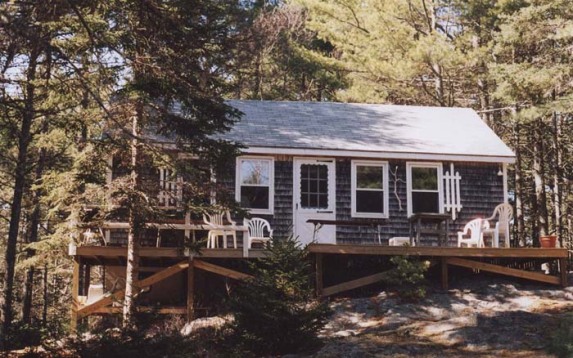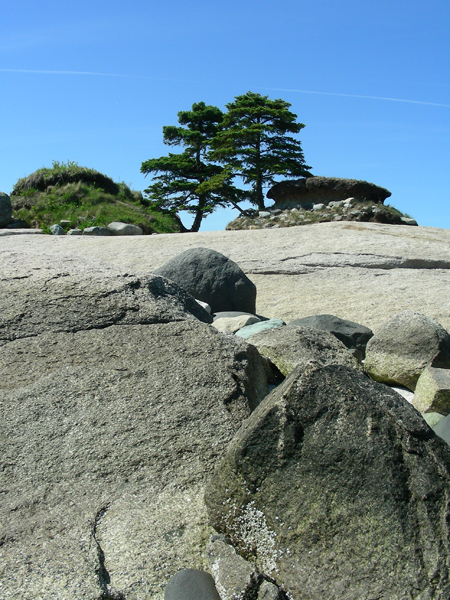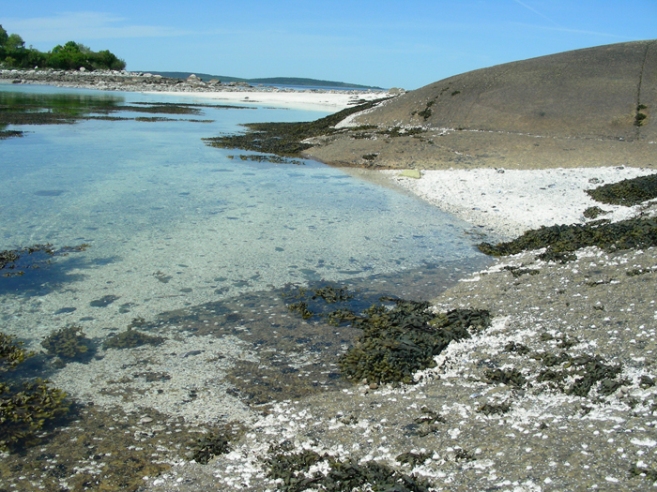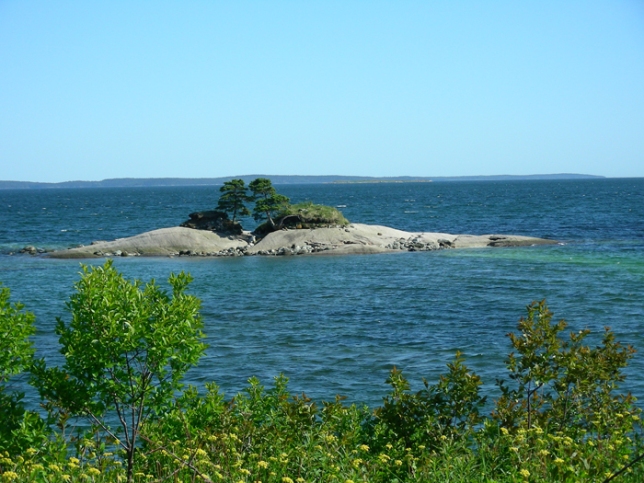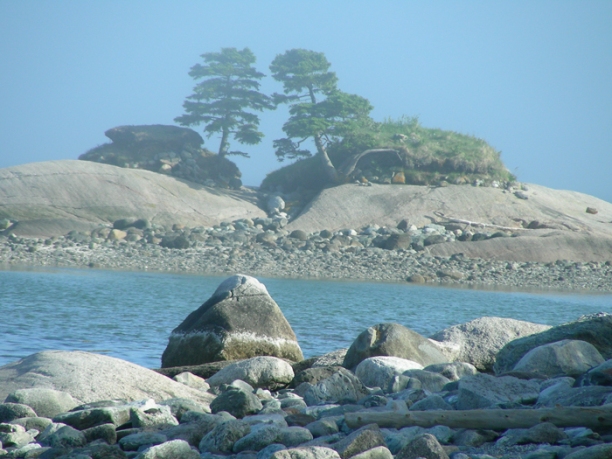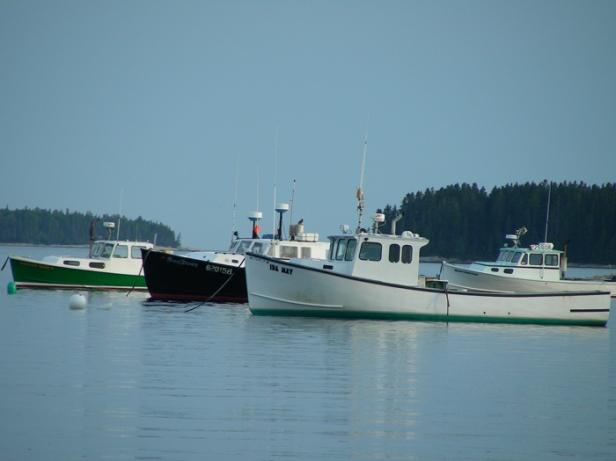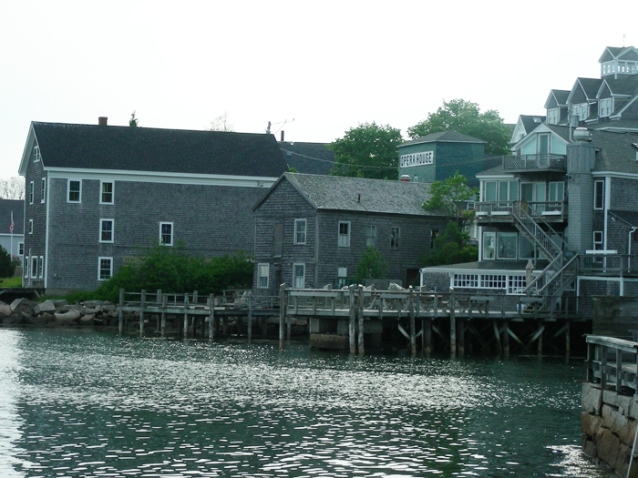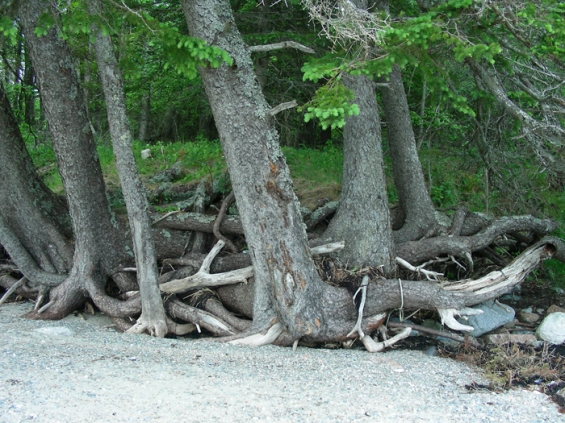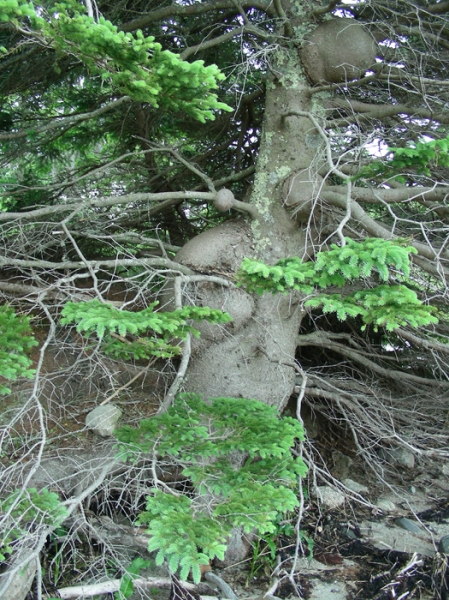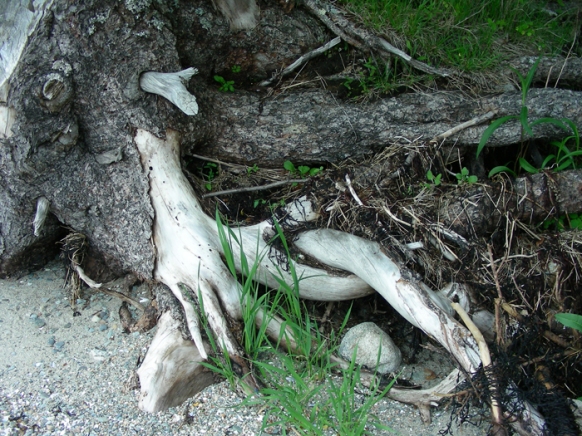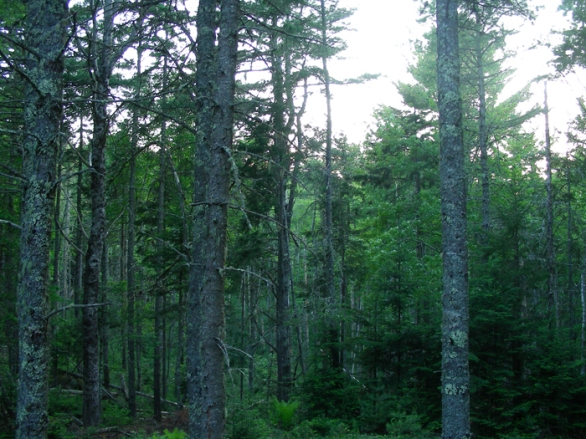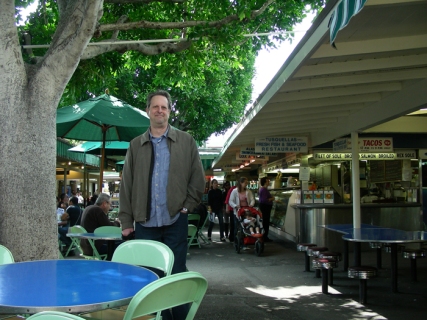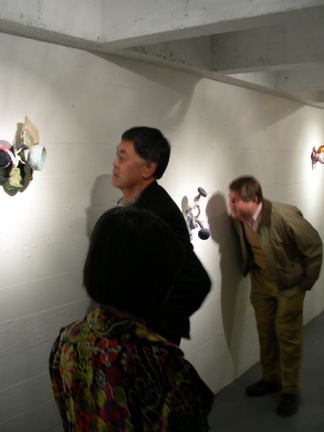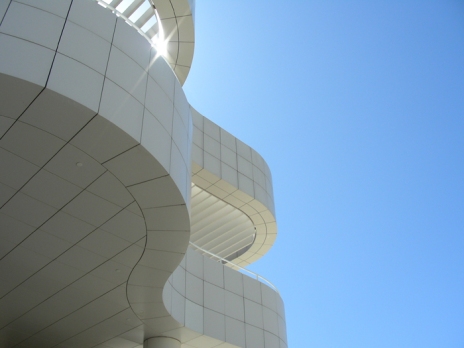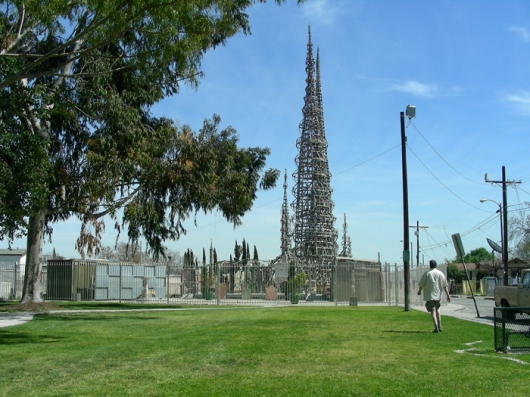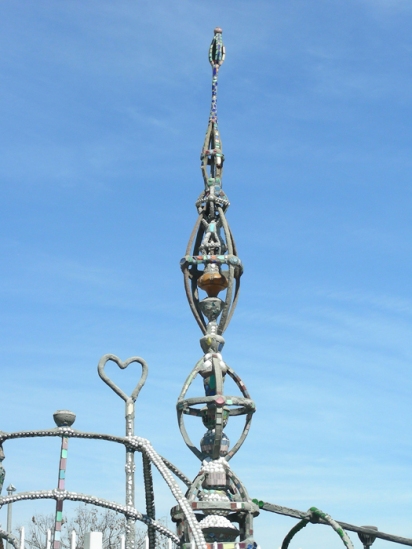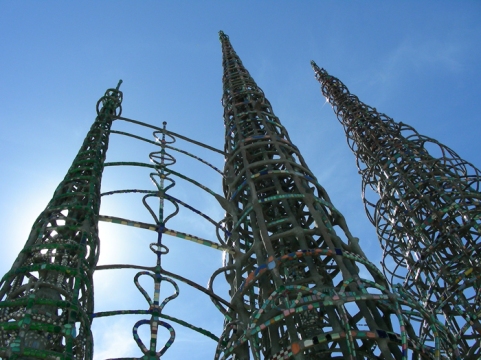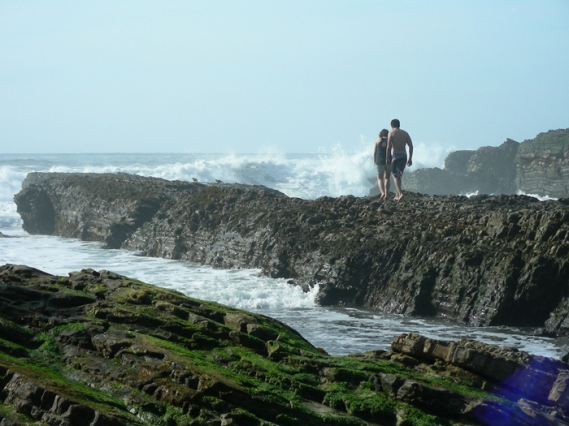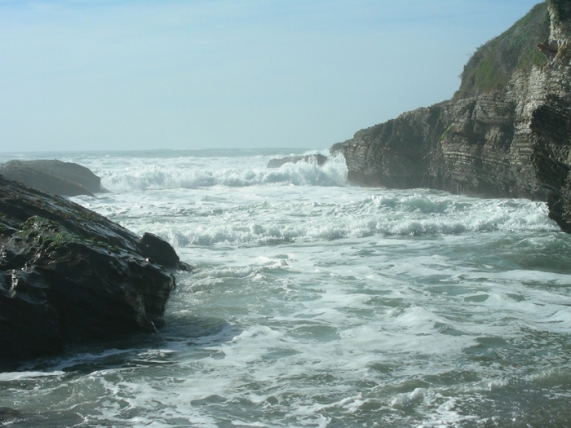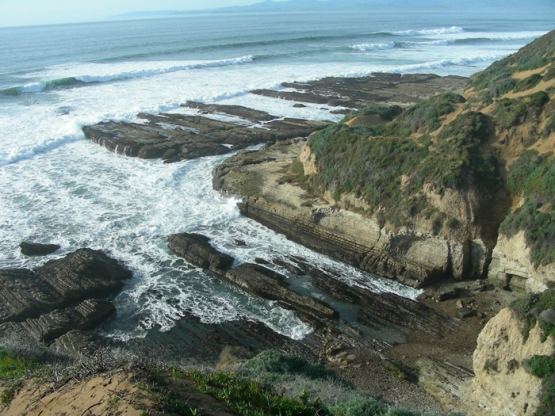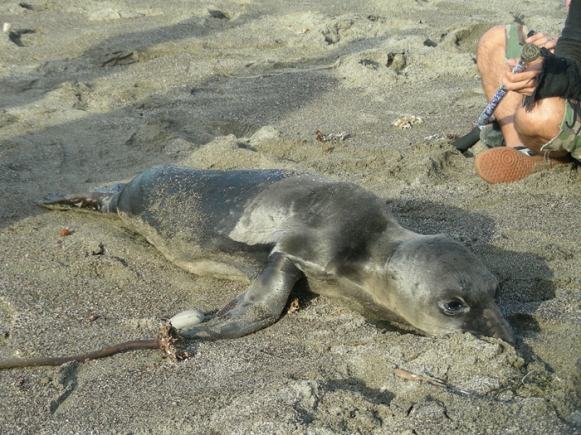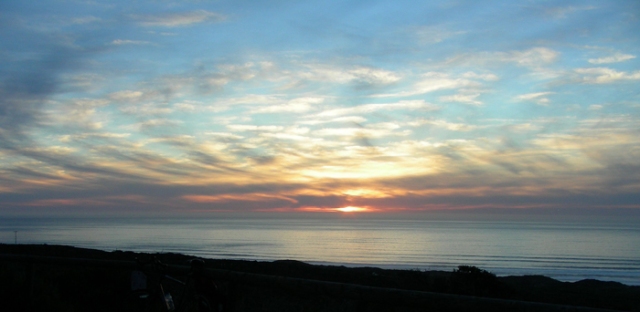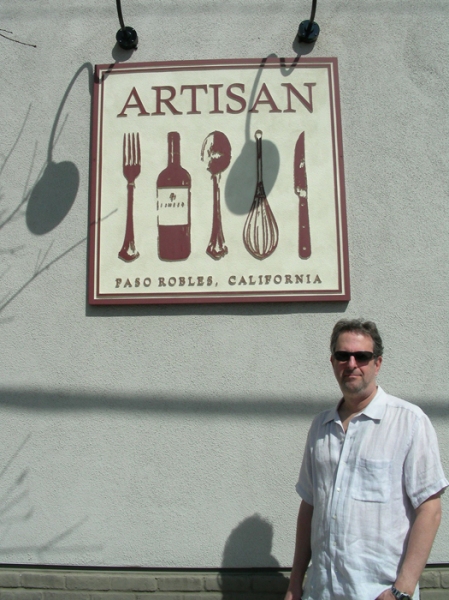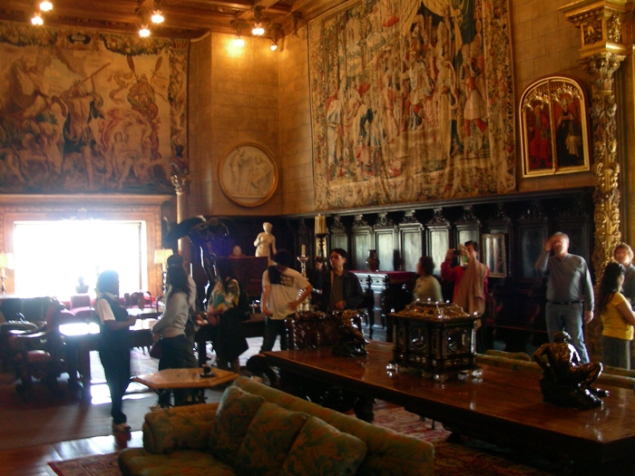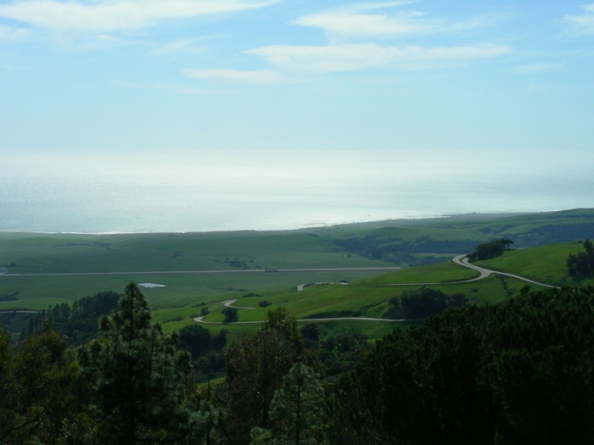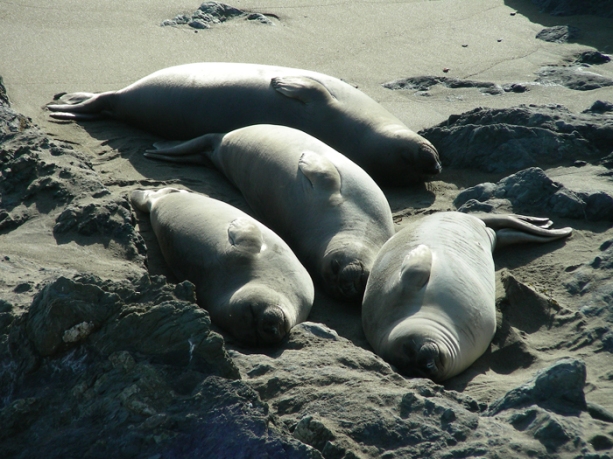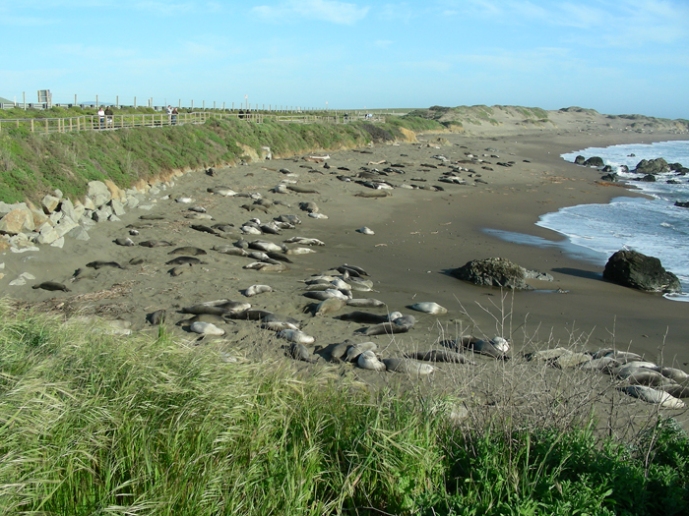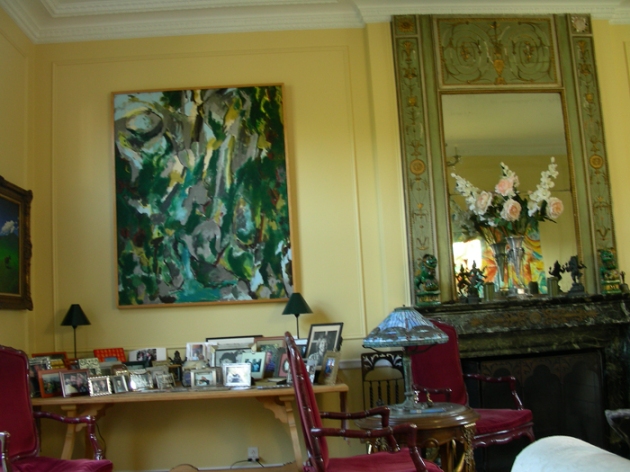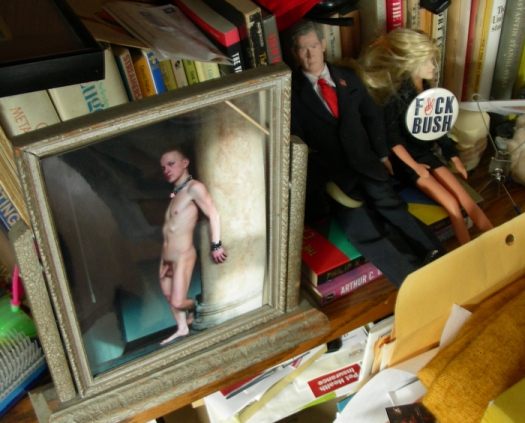The Gowanus section of south Brooklyn gets its fame from the infamous (and now superfunded) canal of the same name. The hardscrabble industrial lots littering the ‘hood are being infiltrated by grassroots cultural endeavors/activites such as the Rooftop Films under-the-stars concept that seems inspired by the old drive-in ethos, but without the car.
This was my first visit to a Rooftop program, and clearly I’ve been out of the loop. The doors opened at 8 PM, but we arrived at about 8:30 not excepting a crowd.
Wrong.
The line of beautiful young film festival goers stretched around the block and the venue was sold out. Since I’d been invited by RTF to write something we dutifully waited our turn in the slow moving queue until we got our wristbands.
The American Can layout includes a spacious interior courtyard surrounded on 4 sides by late 19th century factory loft buildings of varying heights. They are all interconnected by a maze of interior passageways. Orange placards marked the route to the roof, but we temporarily lost our way and ended up sitting in the courtyard (which was set up for film viewing as an optional venue for those unfortunate’s not able to get rooftop tickets) for a few minutes until we figured out (duh!) we weren’t yet on the actual roof.
Thank goodness we finally navigated our way up top, emerging onto a NYC rooftop is always an adventure unto itself. The aircraft carrier like expanse of this deck illuminated by local streetlights and low level ambient was enchantingly fairytale. The skyline featured the nearby Hotel Bleu rising up above 4th Ave to the east, and the iconic UHAUL neon glowing brightly. The occasional subway train would appear along the elevated Smith 9th St bridge, visible only by a long line of small, dim yellow windows moving slowly down into the tunnel.
While the crowd gradually filtered onto the roof, live inde type music was performed and simultaneously projected onto the screen. Mellifluous breezes wafted about as I decided to go barefoot, no worries about chewing gum or bedbugs at this movie palace without a ceiling.
Oh yes, and there was a film program!
IFC is one of the big sponsors and so the show opened with a trailer for one of their new features (which I actually thought might be a spoof on trailers, wrong again), then an entertaining spot from Sailor Jerry Spiced Rum (an 86 proof sponsor) detailing a brief history of tattoo art (Sailor Jerry was actually a famous tattoo artist), followed by a cute little stop-motion piece thats Rooftop’s intro.
The theme for the evening was “closings” apropos the last RTF summer event for 2010. Intentionally or otherwise there was also an underlying current of father-son scripts.
“Old Fangs” was such a story. This artfully animated short features a trio of teenage boy-like animal characters cruising about in a sedan. My take was 2 wolves and a panda, but it could’ve been a Siamese cat. In any event, they end up in some spooky woods at dusk, and disembark from their vehicle to wander about on two legs.
Upon encountering a mysterious house in the darkening gloom one of the boys/wolves summons up his courage to enter. The frightening, cigarette smoking satanic black wolf beast within turns out to be dad. Flashbacks to a preadolescent wolf/child with a nurturing, kind mother and a bloodthirsty, deer killing, conquering father serve to impel the moral of the story; that witnessing brutal paternal ambition leads to childhood trauma. I don’t mean to trivialize this riveting little fable done in the tradition of Grimm’s grimmest. This was a grippingly well-done morality tale.
“Chainsaw Finds Jesus” continued the evening’s father/son dramas. A contemporary narrative surrounding two former rock’n’rollers, now fathers. One of the DJ hipster dads wakes up on the sofa as his 10 year old or so son plays porno computer games, a seedy scenario if ever there was one.
He drags the kid out of their grungy suburban looking digs to go visit Chainsaw, dads old rocker buddy and his similarly aged charge. Things go from bad to worse as Chainsaw and dad do a coke deal whilst the kids romp about the neighborhood and one of the boys incurs a bloody dog bite.
The ensuing chaos encompasses some clever black humor supported by a female narrator, who although we never meet her, entertains some revealingly intimate details humorously recited in a deadpan voiceover. Kind of a Cohen Bros-esque dark comedy.
The last father/son theme opens in the bathroom of a Dutch army soldier preparing for a deployment to a “desert war”. His 5 or 6-year-old son sits in front of him at eye level. The man has slathered his head and face in shaving cream while the son drags the razor over his noggin in a series of excruciating close-ups. The rationale being that this macho warrior is going with the marine jarhead look.
Cuts to the child playing loudly with his toy soldiers and humvee’s hammers home without too much irony the Euro liberal take on the alleged evils of Bush era imperialism. Next.
“12 Notes Down” a Danish film about an adolescent choir boy’s struggle to cope with his voice breaking was a nuanced meditation about coming of age. The angelic visage of this vocal prodigy dressed up in his navy blue sailor-boy choir uniform warbling away during a Brahms chorale, is contrasted by his teen angst as girls his age giggle behind his back in school.
The scene in his doctors office as we peer down his throat to witness his tonsils jiggle is disturbingly voyeuristic, almost sexually frank. Oh those Danes.
The feel good ending as he triumphantly concludes his boyhood singer career, had me chuckling to myself thinking that Justin Bieber should have it so good.
“Mary Last Seen” was the last in the group to delve into (late) boyhood. But this was also a truly frightening horror flic (albeit with out any gore).
The opening scene shot on an interstate in upstate NY features a couple in transit. The young man 18-20 years old pulls into a gas station while his lovely young girl friend uses the bathroom. We see him take something small from the car and fling it across the highway. This bad omen is followed by a scene of ravenous sex in the restroom.
Later on the girl complains about her missing cell phone, and we know she’s in trouble. Then parking in the middle of nowhere the boyfriend leads her into the rainy woods for a hike to who-knows-where. He never explicitly threatens her; in fact his sly kindness could be taken for genuine concern as he encourages her “that we’re almost there” during their gloomy trek.
A suddenly unexpected cut with a loud whacking noise elicited some gasps from the audience.
Expecting the worst we go to a shot of a large barn door open in the distance as a drab looking farmer type strides out with what might be a large ax (shutter). But the next scene is of the couple entering a farmhouse porch. But dread becomes more palpable as some sinister looking women folk of the farm converge on their innocent guest, offering to show her to her room.
Her young man affectionately kisses her goodbye; he has to meet the elder “to do some things”.
Roll the credits, “Mary Last Seen” is revealed to us as the title of the movie for the first time, ending any hope for our heroine and effecting a hair raising ending.
One of the highlights of the evening was a documentary called “The Poodle Trainer”, about a late middle age Russian woman who’s found her dream career leading a circus act of highly trained (could this be Pavlov’s granddaughter!?) poodles.
These quaffed little creatures prance and dance about wearing the standard tutus but also some rather unique outfits. One sort of creepy costume was a lion get up with large foam manes, but the dogs also wore masks with cartoony expressions that covered their heads completely. Could this be considered a moderate form of cruelty? I’d guess the doggies didn’t think so, they seemed to adore her, and she they.
Some close up portraits of the dogs were decadently painterly visages reminiscent of Rubens.
The final piece of the night was made by an Iranian painter Laleh Khorramian, and opened with an abstract clip of some kind of molten looking, twisting orange mass vividly shot on a dark background. As the lens pans out the subject becomes apparent. We are watching time-lapse photography of carved orange peels as they curl up from desiccation.
This seemingly mundane natural process is carefully manipulated by shaping peels as roughly hewn miniature figures, shown in various stages of coital-like embrace, intertwining and coiling in on each other as the time-lapse progresses in slightly shaky segments. These engagingly biomorphic sequences are set up in intricately constructed dollhouse like sets, and seem to pulsate with a life of their own.
The evening ended with an afterparty down in the courtyard with an open bar serving tasty rum concoctions and various free bits of chotchkie and bling. Not a bad deal for 10 bucks, good for singles, dates or just people and movie watching.
There will be other performances through Sept, be there or be square:
rooftopfilms.com
Eliot Markell
eliotcm@verizon.net
eliotinditmas.wordpress.com

Hi Joel,
Thanks again for sending me the hardcover edition of Seven Days in the Art World, I think. Truly the most irritating piece of narcissistic, non-fiction I couldn’t put down. Well I shouldn’t say I won’t put it down, just that I read it without chewing more than I had to. Starting with the “how-attractive-am-I-come-hither-you-influential-art-stud” jacket photo of Ms Thorton, with continued liberal doses of female pheromonal innuendo continuing throughout. Ah yes, it helps to be a sex siren to get ahead in an art market populated with dirty old white men.
I must admit that she can shows flashes of knowledgeable commentary, and clearly knows her way around the hierarchy of cynically corrupt art world masters of the universe. I suppose knowing that the owner of Christie’s auction house controls how dealers market artists work in his collection should be of some significant consequence to the laymen, but the whole thing comes as no surprise to me. She does occasionally manage to show a modicum of restraint when it comes to praising Cesar, but goes on to dote on the glories of the pinnacles of art star power without burying anyone. It’s this kind of infatuation with the moguls of Chelsea and London (before their recent downfall) that aggrandizes the idea that art only exists if someone is willing to pay for it.Guys like [Takashi] Murakami will succeed in a conspiracy to put in a retail counter to sell womens’ accessories in a museum retrospective only if its profitable. Murakami may even have some ability as an artist but, that’s not what really interests him,. He’d just as soon sell commodities like oil or gold if it could get him to the top of some heap. It’s all about ambition and winning.
By far the most dreary chapter details the day into evening long “crit” at CalArts. A more fundamentally bullshit excuse for tenure you couldn’t make up. The so-called “art teacher” [Michael] Asher, who conducts these interminably long, insufferably boring, sessions of delusional post grad mental masturbation, interrupted only by pizza breaks and loudly snoring “students” has really gotten away with one. And like all the rest of the charlatans he actually gets paid. Good work if you can get it.
The chapter on the Turner Prize is also rather depressing. That the nominated artists are so blinded by careerism that they permit themselves to be lined up for a beauty contest must really be humiliating to them in retrospect. Just the fact that they are even in the final four means they already have achieved enough of the goodies to establish themselves for life. For these artists to proceed anyway is a sad statement about how vanity has obscured, and even replaced the real value of making art because you love doing it.
Despite the best efforts by the fashionistas at the helm of the art market to convince everyone otherwise, creating art objects that contain a lasting relevance requires a dedication that transcends financial reward. This is not to say that artists shouldn’t get what they deserve, but that they should establish their creative priorities as a way of life and have enough courage, resolve, and ingenuity to stick with it despite temptation.
Arshile Gorky, a retrospective, at the Philadelphia Museum of Art. A commentary by Eliot Markell, December 2009
Edit this entryGorky is one of those well known artists whose work we think we know, but this retrospective is a like finding an open diary. All sorts of intimate things are revealed.
Gorky’s seductively drooping, elegantly looping curvilinear forms are his signature move, but to supplement that impression you need to get down to Ben Franklin Parkway by Jan 6 and re-introduce yourself to this artist’s odyssey.
His life began and ended in trauma and tragedy, in between he made art that sprung from a psyche imbued with creative instinct. The Armenian Genocide of his childhood shaped everything in his art. After the forced marches of Turkish ethnic cleansing, and then watching his mother starve to death, he immigrated to the United States and in an effort to forge a new life and identity changed his name to Arshile (Russian for Achilles) Gorky, in homage to the Russian dramatist. Fortunately this exhibit contains plenty of drama, particularly the second part of his career.
I found the early work after his arrival from Armenia in Boston MA, getting off to a slow start. Some nice, well crafted, but derivative cityscapes and abstracts that don’t hint much at whats to come.
The first things that grabbed my attention were a series of works on paper and paintings called Nighttime, Enigma and Nostalgia based on a small De Chirico painting “Fatal Temple”.
The De Chirico is included in the same room which provides a vital connection to Gorky’s inspiration. I’ve always thought of De Chirico as one of the most influential picture makers of the 20th century. Everyone from Fellini to Guston owed De Chirico a painterly debt, so it was encouraging to see some of Gorky’s seminal art emanating from Giorgio D C.
Since I view De Chirco as a painter first and a Surrealist second, I also find Gorky’s origins more about the personal than the graphically inclined imagery of Surrealism’s post WW 1 dogma and angst.
Gorky really starts to get juicy working from a photograph of himself and his mother. Although the oil painted portraiture from this group is a bit on the stiff side, there is a small ink rendering that is as forceful as any Rembrandt pen and ink. Its here that his story becomes almost as compelling as the art you are about to witness. This small work on paper is so freighted with memory and poignancy that it’s almost like a love note, and you know that this sentiment will propel and infuse everything else Gorky touches.
One constant that I found throughout this exhibition is that Gorky’s studies on paper seem to better represent his highly skilled abilities as a draftsman, and generally provide a deeper sense of his visual poetic narrative. I say this with some remorse since I think most painters (including myself) run up against this sentiment.
Thats not to say Gorky didn’t paint some highly evolved oils on canvas that contain nuanced and profound composition, just that oil paint is resistant to causal manipulation. Twentieth century artists more interested in interpretative imagery generally put aside the technically demanding requirements of polished oil painted perfection. Even though Gorky could probably have made his paintings more classically proficient, to his credit he chose to pursue a more innovative approach.
By the mid 30’s Gorky was ensconced in a studio near Union Sq in NYC. His prestigious neighbors included Stuart Davis and De Kooning. There is small group of portraits on paper of some of his cohorts that extol the virtues of fine lines and a steady hand. These drawings carefully carve their subjects like two dimensional busts in a way that Picasso should have envied.
Gorky’s painting to this point has not been too exciting, but as he continues to delve into the wellspring of his childhood, a series of paintings called “Khorkom” (based on his Armenian hometown) begin to move into a more unencumbered realm. Color brightens and the rigidity of cubist form starts to loosen and detach from a concrete ground and gain some fluidity.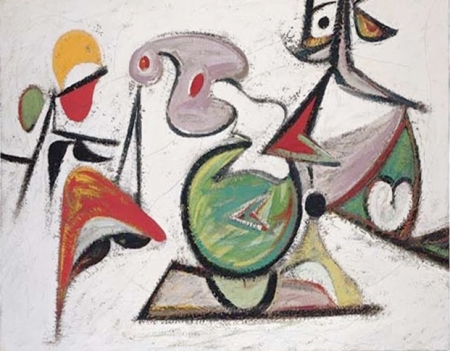
During the Depression Gorky hunkered down in Union Sq while he got involved in the WPA. Although I found his surviving full sized Newark Airport murals overly blocky and heavy handed (obviously influenced by Davis, and not in a particularly good way), again his studies save the day.
One small, elongated rectangular format for a mural design including a tri-engine aircraft, is so precise it seems to morph into an abstract graphite engineering blueprint for propellers. There are also a couple of small, playful gouaches that look like plans for toy planes.
In the forties Gorky begins to enter into his most energetic period. Putting aside his portraiture he launches a series of abstract paintings and gouaches based on his plein air sketches. He and his wife and two daughters relocated to the rural Virginia estate purchased by his father-in-law.
Gorky had started to work from nature a few years earlier in Connecticut, but paintings such as “Garden of Suchi” based on memories of his father’s gardens in Armenia inform and infuse the work from his Virginia oeuvre.
A bucolic dalliance with the birds and the bees inhabit the identity of these paintings, which finally integrate the intimate act of drawing with the broad flourishes of oil paint and gouache. Bursts of color saturate the canvas in transparent washes, fusing intricate lines that seem in a constant state of flux. Solids juxtapose the flatter planes becoming more dimensional, the fuller bodies of these pictures have become more substantially satisfying compositions to the eye.
That Gorky’s mature work arose from his interaction with nature defines and sets him apart from his Abstract Expressionist brethren. I find this to be a breath of fresh air in the domain of sequestered urban studios of most other painters of that time (excluding Pollack’s studio in the Springs, but as far as I know although he painted outside, he didn’t paint from nature).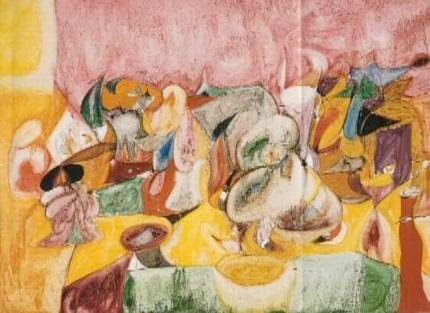
Evocative titles such as “Scent of Apricots on the Fields” and “How My Mothers Apron Unfolds In My Life” populate his work from this period and reflect the fecundity seen spread out in this gallery. (Overall I like the way this show is laid out, but for some unfathomable reason the walls in the large room containing all the Virginia work have been painted with large brown swathes in a straight edged design, moving up and down the walls like a graph?!)
But even as his work rose to new heights theres still lingering doubt for me surrounding the vacancies and voids that haunt his later art, especially in relation to a sense of missing figure /ground connections. Its as though a fog permeates the croma, subsuming and weakening his resolve to work through and completely express a sensation. However this struggle may actually increase Gorky’s aesthetic credibility, he’s not so interested in heroic results as he is in the emotional authenticity of his marks. You can tell he never pandered to critics or collectors; his work and soul is laid bare for all to see, complete with faults, foibles and failings.
What a Sisyphean task his life became at the end. Rectal cancer, a younger wife grown weary of illness and depression takes up with a peer, a devastating studio fire that most likely consumed some of his best art (after losing some of my own best works on paper in a gallery fire in Maine last year, I can attest to the acute sense of loss), and then suicide.
Not only did Gorky endure until the end, but he focused his creative energies as a cathartic cure, throwing himself into the series of paintings called “The Plough and the Song”. The first canvas oozes a murky morass of sepia tints, but you can make out the vaunted Gorky passages emerging. By the time he got to the fourth and last version his mood has lifted significantly. The mise-en-scene recalls a sun drenched picnic of abstracted delight.
There the good cheer ends. The last few rooms are devoted to his most fatalistic work. The series of paintings titled “Charred Beloved” are a gloomy bunch of smoky grey and black visages that seem less of an homage to the lost art, and more a funeral. Then suddenly the “Betrothal” paintings appear personifying everything Gorky strived for. Inverted lily pads drift downwards pulling our gaze along into a vivid dusk populated by unknowable entities striking classic poses like players on a stage. These epic narratives epitomize the unfettered nature of creative intuition, freeform and dreamlike, yet ironically they were closely engineered by Gorky.
Some of his most striking late studies on paper employed the academic grid technique to facilitate assembling his imagery on larger scale. Yet his grids turned out to be a means to an end; they become integral to the visual integrity of his compositions on paper. Its testament to his savvy and guile as a painter that the “Betrothal” paintings seem so animated and elastic.
Of the final work “Diary of a Seducer” is truly spooky and prophetic. Spectral, ghost-like figures gracefully undulate in a softly darkened scene. Prefiguring Guston, a succinctly painted eyeball nestled on a black pillow stares out into the abyss.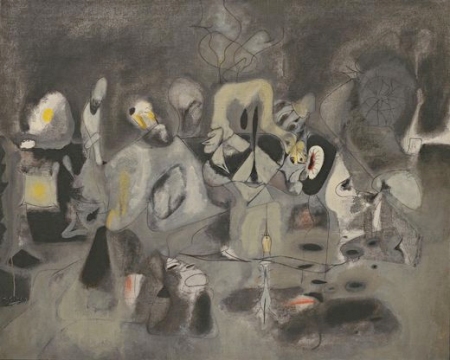
Finally, in 1947 “Limit”, his last painting, embraces Gorky’s ever recurring void. The black, splotchy form hovering mid-field simplifies everything. There is no doubt that this portends death, but theres no sense of urgency. The feel is of profound ambivalence, its not that he didn’t care, just that there was nothing else left to paint.
Arshile Gorky 1902-1948
“I never finish a painting, I just stop working on it for awhile”
Gorky’s seductively drooping, elegantly looping curvilinear forms are his signature move, but to supplement that impression you need to get down to Ben Franklin Parkway by Jan 6 and re-introduce yourself to this artist’s odyssey.
His life began and ended in trauma and tragedy, in between he made art that sprung from a psyche imbued with creative instinct. The Armenian Genocide of his childhood shaped everything in his art. After the forced marches of Turkish ethnic cleansing, and then watching his mother starve to death, he immigrated to the United States and in an effort to forge a new life and identity changed his name to Arshile (Russian for Achilles) Gorky, in homage to the Russian dramatist. Fortunately this exhibit contains plenty of drama, particularly the second part of his career.
I found the early work after his arrival from Armenia in Boston MA, getting off to a slow start. Some nice, well crafted, but derivative cityscapes and abstracts that don’t hint much at whats to come.
The first things that grabbed my attention were a series of works on paper and paintings called Nighttime, Enigma and Nostalgia based on a small De Chirico painting “Fatal Temple”.
The De Chirico is included in the same room which provides a vital connection to Gorky’s inspiration. I’ve always thought of De Chirico as one of the most influential picture makers of the 20th century. Everyone from Fellini to Guston owed De Chirico a painterly debt, so it was encouraging to see some of Gorky’s seminal art emanating from Giorgio D C.
Since I view De Chirco as a painter first and a Surrealist second, I also find Gorky’s origins more about the personal than the graphically inclined imagery of Surrealism’s post WW 1 dogma and angst.
Gorky really starts to get juicy working from a photograph of himself and his mother. Although the oil painted portraiture from this group is a bit on the stiff side, there is a small ink rendering that is as forceful as any Rembrandt pen and ink. Its here that his story becomes almost as compelling as the art you are about to witness. This small work on paper is so freighted with memory and poignancy that it’s almost like a love note, and you know that this sentiment will propel and infuse everything else Gorky touches.
One constant that I found throughout this exhibition is that Gorky’s studies on paper seem to better represent his highly skilled abilities as a draftsman, and generally provide a deeper sense of his visual poetic narrative. I say this with some remorse since I think most painters (including myself) run up against this sentiment.
Thats not to say Gorky didn’t paint some highly evolved oils on canvas that contain nuanced and profound composition, just that oil paint is resistant to causal manipulation. Twentieth century artists more interested in interpretative imagery generally put aside the technically demanding requirements of polished oil painted perfection. Even though Gorky could probably have made his paintings more classically proficient, to his credit he chose to pursue a more innovative approach.
By the mid 30’s Gorky was ensconced in a studio near Union Sq in NYC. His prestigious neighbors included Stuart Davis and De Kooning. There is small group of portraits on paper of some of his cohorts that extol the virtues of fine lines and a steady hand. These drawings carefully carve their subjects like two dimensional busts in a way that Picasso should have envied.
Gorky’s painting to this point has not been too exciting, but as he continues to delve into the wellspring of his childhood, a series of paintings called “Khorkom” (based on his Armenian hometown) begin to move into a more unencumbered realm. Color brightens and the rigidity of cubist form starts to loosen and detach from a concrete ground and gain some fluidity.

During the Depression Gorky hunkered down in Union Sq while he got involved in the WPA. Although I found his surviving full sized Newark Airport murals overly blocky and heavy handed (obviously influenced by Davis, and not in a particularly good way), again his studies save the day.
One small, elongated rectangular format for a mural design including a tri-engine aircraft, is so precise it seems to morph into an abstract graphite engineering blueprint for propellers. There are also a couple of small, playful gouaches that look like plans for toy planes.
In the forties Gorky begins to enter into his most energetic period. Putting aside his portraiture he launches a series of abstract paintings and gouaches based on his plein air sketches. He and his wife and two daughters relocated to the rural Virginia estate purchased by his father-in-law.
Gorky had started to work from nature a few years earlier in Connecticut, but paintings such as “Garden of Suchi” based on memories of his father’s gardens in Armenia inform and infuse the work from his Virginia oeuvre.
A bucolic dalliance with the birds and the bees inhabit the identity of these paintings, which finally integrate the intimate act of drawing with the broad flourishes of oil paint and gouache. Bursts of color saturate the canvas in transparent washes, fusing intricate lines that seem in a constant state of flux. Solids juxtapose the flatter planes becoming more dimensional, the fuller bodies of these pictures have become more substantially satisfying compositions to the eye.
That Gorky’s mature work arose from his interaction with nature defines and sets him apart from his Abstract Expressionist brethren. I find this to be a breath of fresh air in the domain of sequestered urban studios of most other painters of that time (excluding Pollack’s studio in the Springs, but as far as I know although he painted outside, he didn’t paint from nature).

Evocative titles such as “Scent of Apricots on the Fields” and “How My Mothers Apron Unfolds In My Life” populate his work from this period and reflect the fecundity seen spread out in this gallery. (Overall I like the way this show is laid out, but for some unfathomable reason the walls in the large room containing all the Virginia work have been painted with large brown swathes in a straight edged design, moving up and down the walls like a graph?!)
But even as his work rose to new heights theres still lingering doubt for me surrounding the vacancies and voids that haunt his later art, especially in relation to a sense of missing figure /ground connections. Its as though a fog permeates the croma, subsuming and weakening his resolve to work through and completely express a sensation. However this struggle may actually increase Gorky’s aesthetic credibility, he’s not so interested in heroic results as he is in the emotional authenticity of his marks. You can tell he never pandered to critics or collectors; his work and soul is laid bare for all to see, complete with faults, foibles and failings.
What a Sisyphean task his life became at the end. Rectal cancer, a younger wife grown weary of illness and depression takes up with a peer, a devastating studio fire that most likely consumed some of his best art (after losing some of my own best works on paper in a gallery fire in Maine last year, I can attest to the acute sense of loss), and then suicide.
Not only did Gorky endure until the end, but he focused his creative energies as a cathartic cure, throwing himself into the series of paintings called “The Plough and the Song”. The first canvas oozes a murky morass of sepia tints, but you can make out the vaunted Gorky passages emerging. By the time he got to the fourth and last version his mood has lifted significantly. The mise-en-scene recalls a sun drenched picnic of abstracted delight.
There the good cheer ends. The last few rooms are devoted to his most fatalistic work. The series of paintings titled “Charred Beloved” are a gloomy bunch of smoky grey and black visages that seem less of an homage to the lost art, and more a funeral. Then suddenly the “Betrothal” paintings appear personifying everything Gorky strived for. Inverted lily pads drift downwards pulling our gaze along into a vivid dusk populated by unknowable entities striking classic poses like players on a stage. These epic narratives epitomize the unfettered nature of creative intuition, freeform and dreamlike, yet ironically they were closely engineered by Gorky.
Some of his most striking late studies on paper employed the academic grid technique to facilitate assembling his imagery on larger scale. Yet his grids turned out to be a means to an end; they become integral to the visual integrity of his compositions on paper. Its testament to his savvy and guile as a painter that the “Betrothal” paintings seem so animated and elastic.
Of the final work “Diary of a Seducer” is truly spooky and prophetic. Spectral, ghost-like figures gracefully undulate in a softly darkened scene. Prefiguring Guston, a succinctly painted eyeball nestled on a black pillow stares out into the abyss.

Finally, in 1947 “Limit”, his last painting, embraces Gorky’s ever recurring void. The black, splotchy form hovering mid-field simplifies everything. There is no doubt that this portends death, but theres no sense of urgency. The feel is of profound ambivalence, its not that he didn’t care, just that there was nothing else left to paint.
Arshile Gorky 1902-1948
“I never finish a painting, I just stop working on it for awhile”
We spent 9 days (5/19-28) up in the Blue Hill/Brooklin area of Maine, thanks to the generosity of Jim Conboy and Jane McNichols who lent us their house in the woods for the whole time.
This trip was planned to coincide with the opening of Courthouse Gallery’s spring show that included 2 of my “Mainescape” works on paper. It was also a great opportunity to get a head start on my plein air work for this season.
The weather was absolutely delightful for so relatively early in the year. It almost hit 90F one day, that got some locals complaining; “Ay ya, gwad damn heat keep’in the gwad damn lobsta’s in the gwad damn rocks!”
The first day there we discovered Flye Point in Brooklin, a short drive south past the Eggemoggin Reach. The stunningly beautiful panorama with sweeping vistas and intimate detail immediately got my plein air pigments flowing. Painting there turned out to be a week long processs. The scenery was challenging to work from, a wide range of distant and close up subject matter, tidal flux, oceanic/atmospheric luminosity and chroma that presented unique compositional imperatives.
I found my instincts to work representationaly or more interpretively insinuating themselves into my perspective, clamoring for dominance. The extreme horizontality of nature along the Maine shore seemed mitigated by a voluminous sense of sky and ocean extending into a spherical realm that encompasses a wide-angle curvature, not unlike that of a lens.
Jeanne took the following photos. We spent 5 long afternoons at Flye Point, I was not very good company so Jeanne managed to entertain herself gleaning on the beach and taking photos.



This trip was planned to coincide with the opening of Courthouse Gallery’s spring show that included 2 of my “Mainescape” works on paper. It was also a great opportunity to get a head start on my plein air work for this season.
The weather was absolutely delightful for so relatively early in the year. It almost hit 90F one day, that got some locals complaining; “Ay ya, gwad damn heat keep’in the gwad damn lobsta’s in the gwad damn rocks!”
The first day there we discovered Flye Point in Brooklin, a short drive south past the Eggemoggin Reach. The stunningly beautiful panorama with sweeping vistas and intimate detail immediately got my plein air pigments flowing. Painting there turned out to be a week long processs. The scenery was challenging to work from, a wide range of distant and close up subject matter, tidal flux, oceanic/atmospheric luminosity and chroma that presented unique compositional imperatives.
I found my instincts to work representationaly or more interpretively insinuating themselves into my perspective, clamoring for dominance. The extreme horizontality of nature along the Maine shore seemed mitigated by a voluminous sense of sky and ocean extending into a spherical realm that encompasses a wide-angle curvature, not unlike that of a lens.
Jeanne took the following photos. We spent 5 long afternoons at Flye Point, I was not very good company so Jeanne managed to entertain herself gleaning on the beach and taking photos.

You can walk out to Gander Island at low tide, but you need to keep an eye out because the water comes in fast. Miss Jeanne got caught out there twice. I was too busy painting to grab the camera to get a shot of her wading back, damn!

Looking back to Flye Point from Gander. Hurry Miss Jeanne! We don't want to have to call the Coast Guard.

Wooden Boat's campus is open to the public, shot there.
Fri 3/12
Arrived LAX 1:45 PM PST .
Picked up red Hyundai Elantra, got on the 405 to Wilshire (welcome to Beverly Hills), onto Santa Monica Blvd into WeHo (West Hollywood).
Pulled up to Le Montrose, our cute little boutique hotel nestled into a quiet, formerly (1970’s) bohemian neighborhood near the Sunset Strip (Whiskey a Go-Go is right around the corner). The place tends to cater to minor exec’s in the biz, but Expedia had a great deal there.
The rooftop pool and deck was great for a power breakfast, or a late night Jacuzzi (passé?).
The Farmer’s Market in LA is more of an institution than a happening. Around since the 1930’s and set up as a grid of permanent semi-enclosed booths and shops, it’s a 7-day a week scene with its own off-street parking lot.
We started with breakfast at Du-Par’s a local on-site brunch legend featuring copious servings of comfortable and yummy food. We rambled around afterward taking in all the SoCal ambiance.
My favorite haunt was the hot sauce shop with the spicy labels.
http://www.farmersmarketla.com/history/index.html
Jeanne’s art opening at Jancar Gallery was later that evening. She had created a group of crocheted sculpture just for this show. The gallery is in Chinatown, located on the Chung King pedestrian mall. For reasons unknown to me this little corner of LA now hosts the rough equivalent of an odd sort of left bank. There are about 4 or 5 gallery spaces clustered among dingy Chinese restaurants and gift shops.
Fortunately Tom Jancar has the nicest, largest exhibition space and we were quite pleased with how Jeanne’s work was hung. (Although Jeanne took pains to send plenty of photo documentation of how the pieces were to be oriented, one of them was upside down. In typical Tremel fashion she quickly got it right side up with out anyone noticing)
Mery Lynn McCorkle an old friend of Jeanne’s from Williamsburg had curated the downstairs project room exhibitions for several years, but this was her last effort in that regard. Mery Lynn had a solo exhibit upstairs in the main gallery opening the same night, so we had a nice reunion at the gallery.
http://www.jancargallery.com/
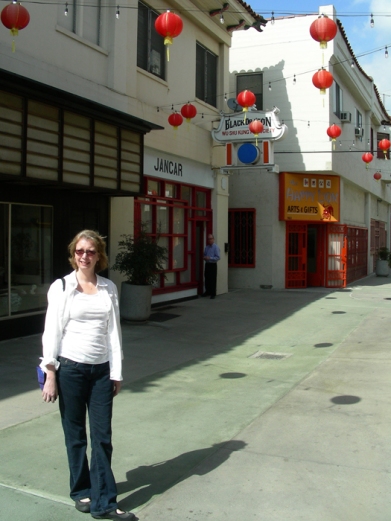
Sun 3/14
Off to the Getty after room service brought our breakfast up to the roof deck, spoiled rotten!
Even though the Getty epitomizes the ostentatious, big money museum with over sized architectural ambitions, somehow the grandiose scale humanizes itself. The place is like a Greek temple, paying homage to the art gods, but receptive, even welcoming to the peasant folk. I overheard a docent mention that a scene from a “Star Wars” movie was shot on one of the balconies, how populist can you get!?
The gardens and open air feel are inviting and take the edge off museum overcrowding, and they actually allow photography of the permanent collection.
Jeanne knew they had an important James Ensor painting we really wanted to see, Christ’s Entry into Brussels. There it was in all its macabre glory, it hadn’t been included in the terrific MOMA exhibit last year, so it was great to get to stand in front of it, up close and personal.
http://www.getty.edu/art/gettyguide/artObjectDetails?artobj=932
There was also a brilliant Courbet that I’d never seen called Grotto of Sarrazine near Nans-sous-Sainte-Anne:
http://www.getty.edu/art/acquisitions/courbet.html
Our next stop was Venice Beach and Jeanne’s first foray onto the wet sand of the great western ocean.
But first the Muscle Beach boardwalk. The Venice Beach neighborhood hadn’t changed much since I’d first visited in the mid 80’s except that perhaps there weren’t so many roller blades. The dependably funky crowd of creeps, cretins, and curmudgeons made for an entertaining afternoon of gawking.
We had arranged to meet Miriam, an old friend of Jeanne’s who had been at her opening the night before. She brought her 2 pre-teen kids who were having a great time blowing their allowance on trinkets and doodads. I wish I’d had as fun a place to go when I was 9 or 10.
We watched the sun plunk down under the horizon headed toward Japan.
Mon 3/15
About 4 AM I am awakened by a loud creaking noise that at first I think is someone trying to get the door to our room open. Then the bed starts shaking noticeably, I’m ready to rouse Jeanne, but suddenly its over. A paltry 4.6, the morning news programs are giddy with man-in-the-street stuff and making sure that you know you should have a loud whistle in your earthquake survival kit in case you’re buried in rubble. (wonder if they’re passing out whistles in Port au Prince now).
Made our way over to BLD (Breakfast Lunch Dinner) for brunch. Best known for their blueberry ricotta pancakes, and that is of course what I had. Quite a treat! By about 10 AM it was already in the upper 70’s so we sat out in the shaded sidewalk café when Jeanne spotted the famed “Hollywood” sign. Nice LA moment.
Our main event today was a trip to see the Watts Towers. I’d never heard of them but fortunately Jeanne was reminded after spotting a blurb in “Where” (a local LA glossy ala New York Magazine).
Built by an immigrant Italian bricklayer over 30 years between the 1930’s to the 1950’s they rise up incongruously over the low-lying neighborhood, an homage to the obsessive-compulsive nature of great outsider art.
http://www.wattstowers.us/

Tue 3/16
LA was in the rear view mirror as we headed north for a couple of nights in the central coast region.
We took the Pacific Coast Highway out of Malibu hugging the coast for the first hour or so. What a great road, twisting and turning its way through various inlets and bays with spectacular ocean vistas and beckoning beaches. The route then heads inland, passing through sprawling fields of cultivated strawberries, finally coming out to the 101 in Oxnard.
We stepped on the gas and flew low up through the sometimes craggy, sometimes gently rolling and grassy hills north of Santa Barbara. Jeanne really needed some quality beach time so we had to get to Los Osos ASAP.
The town of Los Osos is just south of Morro Bay, it’s a quiet and unremarkable little hamlet, but if you continue west for a few miles you enter the Montaná de Oro State Park which is quite remarkable. This CA state park is a lesser known locale than Big Sur but features spectacular and pristine bluffs and beaches equal to Big Sur. The most accessible beach is called Spooner’s Cove where we spent the rest of the afternoon.
We had a very unique wildlife experience at Spooner’s Cove. I had been up on a bluff taking pictures and when I came back down I found Jeanne with a small group of people surrounding what turned out to be a baby Elephant seal. This pathetic looking creature had obviously been separated from its mother and tossed on the beach by the strong surf. (I was amazed by the size of the breakers, some of which had to be cresting at 15 feet) Jeanne had watched it make its way up the beach toward the base of a bluff where it now lay flipping sand on its back with it’s flipper.
I got in the car and found a spot up above the beach where I could get cell phone reception and called 911. The operator seemed concerned and patched me through to CA Fish & Game who got a park ranger to the scene in less than 5 minutes. He immediately made everyone get at least 20 feet away from the critter, and you could see it relax and doze off. He explained that that seals tend to get agitated around people and that this infant was under-nourished to begin with.
The plan was for Fish & Game to arrive within a few hours and transport the seal to a facility in Monterey that would nurse the seal back to good health and then release it. Apparently this kind of thing happens on a regular basis and since Elephant seals are a protected species they get this kind of care.
We didn’t wait around, but hopefully this had a happy ending.
Arrived LAX 1:45 PM PST .
Picked up red Hyundai Elantra, got on the 405 to Wilshire (welcome to Beverly Hills), onto Santa Monica Blvd into WeHo (West Hollywood).
Pulled up to Le Montrose, our cute little boutique hotel nestled into a quiet, formerly (1970’s) bohemian neighborhood near the Sunset Strip (Whiskey a Go-Go is right around the corner). The place tends to cater to minor exec’s in the biz, but Expedia had a great deal there.
The rooftop pool and deck was great for a power breakfast, or a late night Jacuzzi (passé?).
I was immediately sold on cruising around LA, that big sunny cerulean sky beaming down on all those left turn bays, excellent! Local streets are wide and much easier to navigate than here in the Crammed Apple, u-turns are a breeze. (just after I hung a quick u-turn in the middle of Sunset Blvd at about 10 PM to park, the valet pointed out the LAPD cruiser eyeballing me. Didn’t get pinched) The sheer volume of traffic is stunning, but so is the runway-like expanse of the freeways. Sure there was plenty of “pauk jaumed” traffic (as they say in Flatbush), but theres always a nice view of the snow capped San Gabriel’s.
It dawned on me that its likely that west coast limited access highways are referred to with a “the” in front because they are a destination unto themselves. Its like going to “the” bank, or to “the” bathroom, a goal oriented activity that provides a tangible result, in this case joining the mass pilgrimage to wherever everyones going. Its all about lifestyle.
My man in LA, Mark Sprecher (who hates to drive, but still manages to love LA somehow) and his spouse Paul suggested we all meet that evening at Pizzeria Mozzo, Mario Batali’s left coast bastion of succulence over on Montrose. I’d managed to snag a reservation several weeks in advance, and a good thing I did. This was one of the culinary highlights of our trip.
You have to start with their antipasti which are really more like tapas. The bone marrow al forno is a gooey delight served inside large (maybe 2” diameter), piping hot bones, alongside a garlicky relish with toast on a bed of greens. This dish may not be for the finicky, but those with a slightly adventurous palette will be rewarded handsomely.
Also not to be missed are the fried squash blossoms with ricotta, A number-one, and the Cauliflower gratinate.
My favorite pizza was the Bacon, salami, fennel sausage, guanciale, tomato & mozzarella, to die for.
The olive oil gelato for dessert must be the reason mouths were invented. Just a slight tang of salt smoothed over by the chilled, silky sweet goodness of the fruity olive essence.
http://www.mozza-la.com/pizzeria/about.cfm
Sat 3/13It dawned on me that its likely that west coast limited access highways are referred to with a “the” in front because they are a destination unto themselves. Its like going to “the” bank, or to “the” bathroom, a goal oriented activity that provides a tangible result, in this case joining the mass pilgrimage to wherever everyones going. Its all about lifestyle.
My man in LA, Mark Sprecher (who hates to drive, but still manages to love LA somehow) and his spouse Paul suggested we all meet that evening at Pizzeria Mozzo, Mario Batali’s left coast bastion of succulence over on Montrose. I’d managed to snag a reservation several weeks in advance, and a good thing I did. This was one of the culinary highlights of our trip.
You have to start with their antipasti which are really more like tapas. The bone marrow al forno is a gooey delight served inside large (maybe 2” diameter), piping hot bones, alongside a garlicky relish with toast on a bed of greens. This dish may not be for the finicky, but those with a slightly adventurous palette will be rewarded handsomely.
Also not to be missed are the fried squash blossoms with ricotta, A number-one, and the Cauliflower gratinate.
My favorite pizza was the Bacon, salami, fennel sausage, guanciale, tomato & mozzarella, to die for.
The olive oil gelato for dessert must be the reason mouths were invented. Just a slight tang of salt smoothed over by the chilled, silky sweet goodness of the fruity olive essence.
http://www.mozza-la.com/pizzeria/about.cfm
The Farmer’s Market in LA is more of an institution than a happening. Around since the 1930’s and set up as a grid of permanent semi-enclosed booths and shops, it’s a 7-day a week scene with its own off-street parking lot.
We started with breakfast at Du-Par’s a local on-site brunch legend featuring copious servings of comfortable and yummy food. We rambled around afterward taking in all the SoCal ambiance.
My favorite haunt was the hot sauce shop with the spicy labels.
http://www.farmersmarketla.com/history/index.html
Jeanne’s art opening at Jancar Gallery was later that evening. She had created a group of crocheted sculpture just for this show. The gallery is in Chinatown, located on the Chung King pedestrian mall. For reasons unknown to me this little corner of LA now hosts the rough equivalent of an odd sort of left bank. There are about 4 or 5 gallery spaces clustered among dingy Chinese restaurants and gift shops.
Fortunately Tom Jancar has the nicest, largest exhibition space and we were quite pleased with how Jeanne’s work was hung. (Although Jeanne took pains to send plenty of photo documentation of how the pieces were to be oriented, one of them was upside down. In typical Tremel fashion she quickly got it right side up with out anyone noticing)
Mery Lynn McCorkle an old friend of Jeanne’s from Williamsburg had curated the downstairs project room exhibitions for several years, but this was her last effort in that regard. Mery Lynn had a solo exhibit upstairs in the main gallery opening the same night, so we had a nice reunion at the gallery.
http://www.jancargallery.com/

Jeanne in front of Jancar Gallery, Tom Jancar in background (before we had introduced ourselves and he knew who we were)
Off to the Getty after room service brought our breakfast up to the roof deck, spoiled rotten!
Even though the Getty epitomizes the ostentatious, big money museum with over sized architectural ambitions, somehow the grandiose scale humanizes itself. The place is like a Greek temple, paying homage to the art gods, but receptive, even welcoming to the peasant folk. I overheard a docent mention that a scene from a “Star Wars” movie was shot on one of the balconies, how populist can you get!?
The gardens and open air feel are inviting and take the edge off museum overcrowding, and they actually allow photography of the permanent collection.
Jeanne knew they had an important James Ensor painting we really wanted to see, Christ’s Entry into Brussels. There it was in all its macabre glory, it hadn’t been included in the terrific MOMA exhibit last year, so it was great to get to stand in front of it, up close and personal.
http://www.getty.edu/art/gettyguide/artObjectDetails?artobj=932
There was also a brilliant Courbet that I’d never seen called Grotto of Sarrazine near Nans-sous-Sainte-Anne:
http://www.getty.edu/art/acquisitions/courbet.html
Our next stop was Venice Beach and Jeanne’s first foray onto the wet sand of the great western ocean.
But first the Muscle Beach boardwalk. The Venice Beach neighborhood hadn’t changed much since I’d first visited in the mid 80’s except that perhaps there weren’t so many roller blades. The dependably funky crowd of creeps, cretins, and curmudgeons made for an entertaining afternoon of gawking.
We had arranged to meet Miriam, an old friend of Jeanne’s who had been at her opening the night before. She brought her 2 pre-teen kids who were having a great time blowing their allowance on trinkets and doodads. I wish I’d had as fun a place to go when I was 9 or 10.
We watched the sun plunk down under the horizon headed toward Japan.
Mon 3/15
About 4 AM I am awakened by a loud creaking noise that at first I think is someone trying to get the door to our room open. Then the bed starts shaking noticeably, I’m ready to rouse Jeanne, but suddenly its over. A paltry 4.6, the morning news programs are giddy with man-in-the-street stuff and making sure that you know you should have a loud whistle in your earthquake survival kit in case you’re buried in rubble. (wonder if they’re passing out whistles in Port au Prince now).
Made our way over to BLD (Breakfast Lunch Dinner) for brunch. Best known for their blueberry ricotta pancakes, and that is of course what I had. Quite a treat! By about 10 AM it was already in the upper 70’s so we sat out in the shaded sidewalk café when Jeanne spotted the famed “Hollywood” sign. Nice LA moment.
Our main event today was a trip to see the Watts Towers. I’d never heard of them but fortunately Jeanne was reminded after spotting a blurb in “Where” (a local LA glossy ala New York Magazine).
Built by an immigrant Italian bricklayer over 30 years between the 1930’s to the 1950’s they rise up incongruously over the low-lying neighborhood, an homage to the obsessive-compulsive nature of great outsider art.
http://www.wattstowers.us/
Next we got on the 405 for a cruise up to Mulholland Drive to check out the Hollywood Hills. Mulholland runs east-west across a ridge top over looking the Los Angeles basin. All the super exclusive homes are east of the 405, so I decided to head west where Mulholland seemed to just peter out on the map.
After a short drive the road did indeed become really narrow and steep, and then became unpaved and unnamed as it wound its way up precipitous mountain switchbacks. Jeanne was getting a little nervous, this would not have been a good place to get stuck, but we finally rounded a curve and came out to a grand vista where the road ended.
The place was called San Vincente Mountain, and there turned out to be an old Nike missile base just a short walk up above. It had become a hot afternoon and even though we were close to 2000 feet above sea level the air was still and the sun was beating down. But everything was green, verdant and fragrant after all the late winter rains. A bluebird wafting over a rugged ravine snatched a bug with its beak in mid air.
After a short drive the road did indeed become really narrow and steep, and then became unpaved and unnamed as it wound its way up precipitous mountain switchbacks. Jeanne was getting a little nervous, this would not have been a good place to get stuck, but we finally rounded a curve and came out to a grand vista where the road ended.
The place was called San Vincente Mountain, and there turned out to be an old Nike missile base just a short walk up above. It had become a hot afternoon and even though we were close to 2000 feet above sea level the air was still and the sun was beating down. But everything was green, verdant and fragrant after all the late winter rains. A bluebird wafting over a rugged ravine snatched a bug with its beak in mid air.

Tue 3/16
LA was in the rear view mirror as we headed north for a couple of nights in the central coast region.
We took the Pacific Coast Highway out of Malibu hugging the coast for the first hour or so. What a great road, twisting and turning its way through various inlets and bays with spectacular ocean vistas and beckoning beaches. The route then heads inland, passing through sprawling fields of cultivated strawberries, finally coming out to the 101 in Oxnard.
We stepped on the gas and flew low up through the sometimes craggy, sometimes gently rolling and grassy hills north of Santa Barbara. Jeanne really needed some quality beach time so we had to get to Los Osos ASAP.
The town of Los Osos is just south of Morro Bay, it’s a quiet and unremarkable little hamlet, but if you continue west for a few miles you enter the Montaná de Oro State Park which is quite remarkable. This CA state park is a lesser known locale than Big Sur but features spectacular and pristine bluffs and beaches equal to Big Sur. The most accessible beach is called Spooner’s Cove where we spent the rest of the afternoon.
We had a very unique wildlife experience at Spooner’s Cove. I had been up on a bluff taking pictures and when I came back down I found Jeanne with a small group of people surrounding what turned out to be a baby Elephant seal. This pathetic looking creature had obviously been separated from its mother and tossed on the beach by the strong surf. (I was amazed by the size of the breakers, some of which had to be cresting at 15 feet) Jeanne had watched it make its way up the beach toward the base of a bluff where it now lay flipping sand on its back with it’s flipper.
I got in the car and found a spot up above the beach where I could get cell phone reception and called 911. The operator seemed concerned and patched me through to CA Fish & Game who got a park ranger to the scene in less than 5 minutes. He immediately made everyone get at least 20 feet away from the critter, and you could see it relax and doze off. He explained that that seals tend to get agitated around people and that this infant was under-nourished to begin with.
The plan was for Fish & Game to arrive within a few hours and transport the seal to a facility in Monterey that would nurse the seal back to good health and then release it. Apparently this kind of thing happens on a regular basis and since Elephant seals are a protected species they get this kind of care.
We didn’t wait around, but hopefully this had a happy ending.
Wed 3/17
After spending the night in Morro Bay in a modest but cozy little motel (theres nothing fancy for food or lodging in Morrow Bay, the previous evening we had walked in the door for dinner of the busiest establishment in town just before they were getting ready to close at 8 PM. We had to eat in a hurry), the next morning we headed over to Morro Rock for more beach time.
This awesome mound of rock towering over 500 feet juts out of the bay, dominating the scenery. It’s a 21 million year old volcanic plug that was used as a quarry until 1969, its now a bird sanctuary.
After spending the night in Morro Bay in a modest but cozy little motel (theres nothing fancy for food or lodging in Morrow Bay, the previous evening we had walked in the door for dinner of the busiest establishment in town just before they were getting ready to close at 8 PM. We had to eat in a hurry), the next morning we headed over to Morro Rock for more beach time.
This awesome mound of rock towering over 500 feet juts out of the bay, dominating the scenery. It’s a 21 million year old volcanic plug that was used as a quarry until 1969, its now a bird sanctuary.
We had busy day in store; a short trip inland to Paso Robles for an early lunch reservation at Artisan, one of the premier dining establishments in California, and then a 3 PM tour at the Hearst Castle.
Artisan is anchored to the nearby central coast wineries and farms, and serves a truly inspired and creative menu based on those riches. The room itself is relatively spare, a lot of comfortably spacious, dark mahogany looking banquets and chairs that are offset by large windows looking out onto the broad streets of downtown Paso Robles.
We started with the “Local Elite Flight” which included a spectacularly good single vineyard blend; the Booker Syrah/Cab Sauvignon/Cab Franc/Petit Verdot “Remnant”, ’05, produced, as our waitress slyly informed us by an “old hippie” type. Well done long hair.
The cheese plate was entirely sublime, the flavors morphing and melding as the fromage acclimated to room temperature. I couldn’t resist the Hearst Ranch Grass Fed Flatiron Steak, with Fries, shallots, and cabernet butter slathered on top, but I had to apologize later in the day to its kin over in San Simeon.
http://www.artisanpasorobles.com/restaurant-paso-robles-artisan.php
Artisan is anchored to the nearby central coast wineries and farms, and serves a truly inspired and creative menu based on those riches. The room itself is relatively spare, a lot of comfortably spacious, dark mahogany looking banquets and chairs that are offset by large windows looking out onto the broad streets of downtown Paso Robles.
We started with the “Local Elite Flight” which included a spectacularly good single vineyard blend; the Booker Syrah/Cab Sauvignon/Cab Franc/Petit Verdot “Remnant”, ’05, produced, as our waitress slyly informed us by an “old hippie” type. Well done long hair.
The cheese plate was entirely sublime, the flavors morphing and melding as the fromage acclimated to room temperature. I couldn’t resist the Hearst Ranch Grass Fed Flatiron Steak, with Fries, shallots, and cabernet butter slathered on top, but I had to apologize later in the day to its kin over in San Simeon.
http://www.artisanpasorobles.com/restaurant-paso-robles-artisan.php
The Hearst Castle tour is not to be missed, it gives a compelling feel for the mystique of an opulent era. The place reeks of myth, its like walking into a theater piece or an epic Victorian history novel. Curiously, I never envisioned Orson Welles per se, but the Hearst legacy permeates this cathedral-like aerie. Near the end of the tour you get to sit in the original screening room/movie theater and view clips of the likes of Charlie Chaplin cavorting on the tennis courts. A solemn and cranky looking W R Hearst presides over all.
Our last adventure today was to visit the Elephant Seal rookery at Piedras Blancas, just a mile or so up the road from the Hearst Castle visitors center. We’d heard about this place from the ranger who we’d met at Spooner’s Cove, but it’s a fairly well known place anyway.
http://elephantseal.org/
http://elephantseal.org/
The next day we headed back to LA after a brief stop in Santa Barbara for lunch with Mark Sprecher’s sister Anne. We got together at a little Mexican place called Super Rica which is actually quite famous for its causal approach to some of the best Mexican delicacies north of the border.
A must do when in Santa Barbara!
We were spending our last night at Mark Sprecher’s house in the Los Feliz neighborhood just under the Griffith Park Observatory.
Mark and I go all the way back to the mid 70’s when he was living in NY. I was a short order cook at this joint near NYU and Mark was trying his hand as a waiter. We both decided after a lesson from the boss “Big Al” in how to make pubic hair scrambled eggs (dig your hand deep into your crotch for a good itch before breaking eggs) that perhaps we should move onto bigger and better things.
Mark has been a generous patron of my art over the years and certainly has the largest (and only) collection of my paintings west of the Mississippi. Since I hadn’t visited LA in 10 years it was nice to see my work and the rest of his terrific collection again.
Mark and his partner Paul put out a lavish feast of Indian food. (Mark is an accomplished chef having traveled extensively in South Asia and trained at one of the best culinary schools in Thailand)
It was great way to wind up a fantastic trip while bringing back a tan to ward off the grim reality of New York in March.
A must do when in Santa Barbara!
We were spending our last night at Mark Sprecher’s house in the Los Feliz neighborhood just under the Griffith Park Observatory.
Mark and I go all the way back to the mid 70’s when he was living in NY. I was a short order cook at this joint near NYU and Mark was trying his hand as a waiter. We both decided after a lesson from the boss “Big Al” in how to make pubic hair scrambled eggs (dig your hand deep into your crotch for a good itch before breaking eggs) that perhaps we should move onto bigger and better things.
Mark has been a generous patron of my art over the years and certainly has the largest (and only) collection of my paintings west of the Mississippi. Since I hadn’t visited LA in 10 years it was nice to see my work and the rest of his terrific collection again.
Mark and his partner Paul put out a lavish feast of Indian food. (Mark is an accomplished chef having traveled extensively in South Asia and trained at one of the best culinary schools in Thailand)
It was great way to wind up a fantastic trip while bringing back a tan to ward off the grim reality of New York in March.



